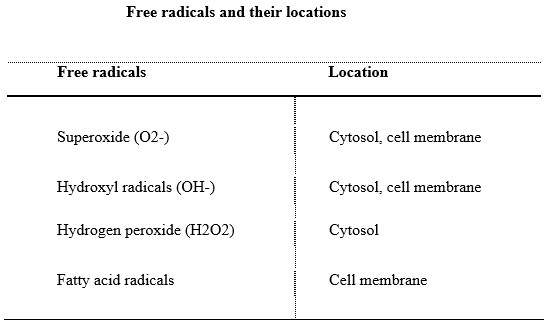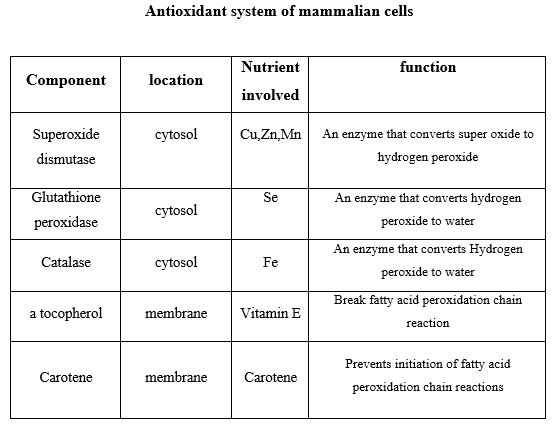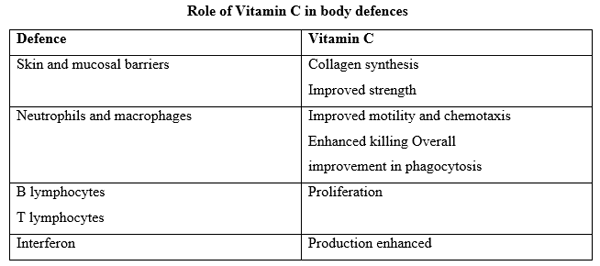Introduction
A number of micronutrients have been shown to affect various aspects of immunity in cattle. The interactions between nutritional status, immunology and disease resistance are extremely complex. Insufficient contents of micronutrients in animal diets have been related with low disease resistance and decreased disease resistance. A balanced supply of micronutrients, such as vitamins E, β- Carotenoids, Vitamin A, Vitamin C and the trace elements zinc (Zn), Copper (Cu), Chromium (Cr), selenium (Se), Manganese (Mn), Cobalt (Co), Iron (Fe) is of great importance for proper functioning of host defence mechanism.
Reproduction is the most important production parameter in attaining profitability in a commercial cattle dairy farm. If cows do not consistently produce a calf every 12 months, than costs of calf raised will increase due to the costs of carrying open/non-productive cows and/or subfertile bulls from year to year. Adequate trace mineral intake and absorption is required for a variety of metabolic functions including immune response to pathogenic challenge, reproduction and growth. Mineral supplementation strategies quickly become complex because differences in trace mineral status of all livestock species is critical in order to obtain optimum production in modern animal production systems. Subclinical or marginal deficiencies may be a larger problem than acute mineral deficiency because specific clinical symptoms are not evident to allow the producer to recognize the deficiency; subclinical trace mineral deficiencies will adversely affect immunity, reproduction and growth long before clinical deficiency symptoms are observed.
Subclinical trace mineral deficiencies are quite common in all livestock (not just cattle) and most producers do not recognize these deficiencies as a problem since they are hard to identify. Animals grow and reproduce seemingly normally; they just do so at reduced rates, more inefficiently and at higher input costs. For these reasons, it is imperative that cattle producers supplement trace minerals in order to maintain efficient production. As animal trace mineral status declines immunity and enzyme functions are compromised first, followed by a reduction in maximum growth and fertility, and finally normal growth and fertility decrease prior to evidence of clinical deficiency. Good management practices and good nutrition are critical for maintaining cattle fertility. Once energy and protein needs are met, cattle need adequate levels of necessary trace minerals in order to maintain high levels of reproductive efficiency. In order to maintain animals in adequate trace mineral status, balanced intake and absorption are necessary.
Host defense mechanisms
The immune system is evolved in vertebrates to protect the body from invasion by ever-changing microbial pathogens.
Immunity
Immunity refers to, reactions by an animal body to foreign substances such as microbes and various macro molecules. A collection of cells and molecules that protect the body against infection, malignancy and damaged cells is called immune system. The immune system is divided into innate or non-adaptive immune system and the acquired or specific or adaptive immune system.
A. Innate or non adaptive or non specific immunity
Innate immunity is composed of –
- physical barriers to infection (skin, mucous membranes in respiratory and other systems, saliva, and physical reflexes such as coughing, sneezing, tear production, inflammation, fever).
- phagocytic cells (neutrophils, macrophages, and natural killer cells).
Cytokines and acute-phase proteins.
B. Acquired or specific or adaptive immune system
The basis of immunity is the ability of the immune system to recognize foreign molecules (antigens) and respond appropriately to them. Immunity is primarily effected by lymphocytes and phagocytes (collectively called leukocytes). Adaptive immunity can be further conceptually divided into two categories i.e. humoral and cell mediated immunity. The cells of the acquired immune system are responsible for synthesizing antibodies, providing memory, and killing invading micro-organisms.
1. Humoral immunity
Humoral immunity is that type of immune protection that can be transferred by blood serum. It encompasses antigen receptors called immunoglobulins, or antibodies that are attached to the surface of B cells (Devereux, 2002). B cells develop in the bone marrow or fetal liver and differentiate into antibody-producing plasma cells. They recognize antigens by their surface immunoglobulins. The MHC Class II molecules and complement receptors are also present on these lymphocytes. In order to produce an antibody response, most B cells require the presence of an antigen (T-dependent antigen) together with help from antigen-specific T cells.
2. Cell mediated immunity
Cell mediated immunity is associated with T-cells. T cells differentiate in the thymus and function to:
- help B cells make antibodies
- kill virus-infected cells
- regulate the level of immune response
- stimulate the microbicidal and cytotoxic activity of other immune effector cells, including macrophages.
T cells recognize antigen and MHC molecules via a receptor molecule. Activated T cells carry MHC class II molecules and also express interleukin 2 (IL-2) receptors. Resting T cells do not possess these molecules. There are three main types of T cells: (i) helper T cells CT,). These cells are stimulated by a combination of an antigen and an MHC Class II molecule found on the surface of an antigen-presenting cell. An antigen-presenting cell is one which is capable of presenting an antigen to lymphocytes in an immunogenic form. Helper T cells interact with B cells to produce antibodies, are involved in the maturation of cytotoxic T cells, and interact with other cells (e.g. macrophages) by secreting lymphokines; (ii) suppressor T cells CT,); (iii) cytotoxic T cells CT).
Oxidative stress and immunity
Sies (1991)reported that oxidative stress in a living organism is a result of an imbalance between reactive oxygen metabolites (ROM) production and neutralizing capacity of antioxidant mechanisms. Oxidative stress is a medical term for damage to animal or plant cells caused by reactive oxygen species, which include superoxide, singlet oxygen, peroxynitrite or hydrogen peroxide. Oxidative stress can take place by three ways:
- abstraction of a hydrogen atom,
- abstraction of an electron or
- addition of oxygen.
There are many different sources by which the reactive oxygen species are generated:
- Electron transport chain in the mitochondria from which oxygen molecules continuously leak as ROS intermediates.
- Immune reactions also contribute to the generation of oxidants, particularly during infections or as a result of autoimmune responses. Activated neutrophils undergoing the respiratory burst release ROS intended to target foreign pathogens, but the lack of specificity in these reactions results in tissue damage to the host.
- Enzymes such as xanthine oxidase and nitric oxide synthase (NOS) produce O2- and NO-. Exogenous sources of ROS also contribute directly or indirectly to the total oxidant load.
Metabolic demands associated with late pregnancy, parturition and initiation of lactation are expected to increase the production of reactive oxygen species (ROS) which result in development of oxidative stress. Immune cells are particularly sensitive to oxidative damage because their cell membrane contains high concentration of polyunsaturated fatty acids (PUFA) which is very susceptible to peroxidation.
Role micronutrients in immunity and fertility
Zinc (Zn)
Zn may affect immunity via its important role in cell replication and proliferation. Zn plays an important role in cell-mediated immunity (Meunier et al., 2005). Zinc influences host defence mechanism via: Phagocytic activity Cell mediated immunity Humoral immunity. Zn deficiency reduces potency of both cellular and antibody response of the immune system to infections. Even minute alterations in the Zn level influence T cell development as well as T cell functions, whereas granulocytes are only influenced by high dosage of Zn or profound zinc deficiency. Monocytes are the only leukocytes which are directly activated by Zn. Zinc is component of numerous enzymes:
- Superoxide dismutase (SOD)
- RNA Polymerase
- DNA polymerase
- Ribonulease
- Thymidine kinase
The copper- and zinc-containing superoxide dismutase (SOD1) protects eukaryotic cells against oxidative stress by scavengingtoxic superoxide anions. Recomonded level of Zn is 40-60 ppm in total diet.
Zinc is known to be essential for sexual maturity, and onset of estrus. Zinc plays a role in epithelial integrity, meaning that zinc is essential for maintaining the lining of the reproductive organs. Adequate zinc levels are vital for repair of the uterine lining following calving, return to normal estrus cycles and maintenance of the uterine lining necessary for implantation of embryos. Inadequate zinc levels in cattle have been associated with abortion, fetal mummification, lower birth weights and prolonged labor. Zinc is also vital to sperm quality in males. Zinc and copper also affect reproduction indirectly through hoof and joint health. Bulls that are lame will not actively seek out cows in heat, follow and mount them. And even if they mount, they may not ejaculate due to associated pain. Therefore, structural soundness of feet and legs is vital to bull reproductive efficiency.
The fetus requires Zn for normal growth and development. Additionally, Zn deficiency results in fetal teratogenesis, prolonged gestation, difficult labor, low birth weight, and weak offspring. Although the specific requirement for Zn during reproduction has not been well established, it is probably higher than for other life stages due to nutrient demand for fetal growth, stress of parturition and milk synthesis during lactation. . Zinc also is an important cofactor in DNA synthesis and gene transcription. Zinc is involved in the formation of prostaglandins because Zn enzymes control the arachidonic acid cascade. Prostaglandins are required for maintenance of pregnancy because PGF2α secretion into the uterine lumen. Zn may enhance conceptus development through its effects on PGF2α synthesis. Prostaglandin F2α is also important at parturition to initiate uterine contractions required for expulsion of the fetus. Another potential pathway for Zn to influence pregnancy is by modulating the action of insulin-like growth factors (IGFs) at the cellular level. Insulin-like growth factors are known to be potent stimulators of tissue differentiation and cell proliferation. These growth factors are present in high levels within the uterus of several livestock species during early pregnancy and may be important in uterine remodeling during the time of embryonic implantation (IGF-I) and fetal development (IGF-II), as well as for conceptus growth in general. The responsiveness of cells to IGF is mediated by the type and number of IGF receptors present on the cell surface and by IGF-binding proteins (IGFBP), which are secreted by cells and inhibit IGF binding to cell surface receptors. In vitro studies using transformed cell lines have demonstrated that Zn decreases the binding affinity of IGF to IGFBP and increases IGF binding affinity for Type 1 IGF receptors on the cell surface. In addition, IGF-1 levels are lowered during Zn deficiency. Therefore, if more Zn is available, more IGF may be transferred from IGFBP to cell surface IGF receptors to promote growth and differentiation.
Copper (Cu)
Cu is needed for proper development and maintenance of the immune system including the formation of antibodies and white blood cells. Copper deficiency results in decreased humoral and cell-mediated immunity, as well as decreased nonspecific immunity. Dietary Cu affects phagocytic as well as specific immune function regulated by phagocytic cells such as macrophages and neutrophils. Two copper-dependent enzymes, ceruloplasmin and superoxide dismutase, exhibit anti-inflammatory activity and may play critical roles in the prevention of oxidative tissue damage resulting from infection and inflammation (Suttle and Jones, 1986). Copper is involved in the antioxidant system via its involvement in the enzymes Cu–Zn superoxide dismutase (SOD). Recommended level of Copper is 20 ppm.
SOD is considered the first line of defense against pro-oxidants. It has been assumed that SOD has a central role in the defense against oxidative stress. Copper-Zinc SOD is a low-molecular weight homodimer containing two copper and two zinc atoms. Three distinct iso-forms of SOD have been identified: two, with Cu and Zn at their catalytic site, are localized either in cytoplasm (Cu/Zn–SOD, SOD1), or extracellularly (EC–SOD, SOD3). A third iso-form has been localized in mitochondria with Mn as a cofactor (Mn–SOD, SOD2). The major defense in detoxification of superoxide anion and hydrogen peroxide, are superoxide dismutase (SOD), catalase and glutathione peroxides. O2 molecule is completely reduced to 2H2O by accepting 4 electrons in the cell. If O2 is partially reduced by accepting 2 electrons, the product is H2O2. If O2 accepts only one electron, the product is superoxide radical (:O2- ). H2O2 and : O2- are extremely toxic to cell as they attack UFA component of membrane lipids and damage membrane structures. Cells protect themselves against H2O2 and : O2- by the action of SOD(1) and Catalase (2).
(1) 2 : O2- + 2H+-------SOD-----à H2O2 + O2
(2) 2 H2O2 ---- -- - Catalase-----à 2 H2O +O2
It is theorized that reproductive efficiency is reduced due to alterations of enzyme systems caused by low copper levels. Copper deficiency can result in delayed estrus, reduced libido, decreased conception rates, infertility and early embryo death, necrosis of the placenta and central nervous system abnormalities in offspring. High levels of iron, sulfur or molybdenum in the soil or additional feed supplements can further exaggerate these deficiency symptoms. Copper deficiency is a serious problem for grazing cattle. Newborns are very dependent on copper acquired during the prenatal period since copper levels in milk are poor. Therefore, proper copper nutrition in gestating females is critical to body stores in newborns. Maternal copper deficiency has been linked to increased mortality and morbidity in lambs and calves
Chromium (Cr)
Several studies have indicated that supplementation of Cr to dairy cattle, in a biologically-available form (e.g., Cr-amino acid complex or Cr-yeast), benefits immunity. Chromium supplemented calves also had increased serum immunoglobulin concentrations.
- Chromium supplementation improves cell-mediated and humoral immune response as well as resistance to respiratory infection in stressed cattle.
- Cr supplementation in cattle decreased serum cortisol concentration.
- Stress results in elevated blood concentration of cortisol which is known to depress immune functions.
- Lymphocytes from cows supplemented with Cr had increased blastogenic responses to Con A stimulation.
Iron (Fe)
The most profound changes associated with low iron levels are the reduction of peripheral T-cells, impairment of phagocyte, natural killer activities, lymphocyte interleukin-2 production, decreased delayedtype hypersensitivity and the thymus atrophy. Iron deficiency anaemia were found to have impaired neutrophil bactericidal activities and cell mediated immune functions which were reversible with adequate iron therapy.
Selenium (Se) and Vitamin E
Selenium was first identified in the 1930s as a toxic element to some plants and animals. However, selenium is now known to be required by laboratory animals, food animals, and humans. Selenium is an anti-oxidant that works in conjunction with Vitamin E to prevent and repair cellular damage in the body. Selenium and/or Vitamin E deficiency has been shown to impair immune response. Selenium is also associated with thyroxine, a thyroid hormone that regulates metabolism, reproduction, circulation and muscle function. Selenium also protects the body from heavy metals by forming complexes to render them harmless. Selenium is readily transferred through the placenta and milk; therefore, a cow’s selenium status will directly affect the health and thriftiness of her calf.
Combining the two supplements results in the greatest increase in defense against mastitis. Deficiencies of vitamin E and selenium also have been found to increase the incidence of retained placenta. Selenium deficiency alone can increase the incidence of embryonic death and uterine infections and can decrease fertility.Suggested Feeding Levels of vit. E in Total Diet is 1000 IU/day for dry cows, 500 IU/day for lactating cows and 0.3 ppm Selenium. Hogan et al. (1990) reported that Se enhanced neutrophil killing activity. Maddox et al. (1999) have reported that Se deficiency increases neutrophil adherence and Spears (2000) has speculated that altered adherence could affect ability of neutrophils to attack and sequester pathogen. The antioxidant roles of vitamin E and selenium, via the metalloenzyme glutathione peroxidase, share common biological activities. The sparing of one will impact the functionality of the other. Se function as an essential component of the enzyme Glutathione peroxidase, which destroys H2O2 and lipid hydroperoxides. vit. E protects the cell membranes from peroxyl radicals produced from PUFA and yield stable lipid hydroperoxide, which is harmless.
Cobalt and Vitamin B12
Cobalt is essential in ruminant diets for the synthesis of vitamin B12. Cobalt may also be beneficial in ruminant diets as a means of improving the efficiency of fiber digestion by bacteria. Although cobalt requirements are less than 1 ppm in the diet, cobalt deficiency has devastating effects on animal health. Feeding a well fortified trace mineralized salt containing cobalt is the best means of insuring that animals get adequate cobalt nutrition. In ruminants, Vitamin B12 is produced from cobalt by microbes in the rumen. Hence, complete replacement of cobalt by Vitamin B12 in ruminant diets is not possible due to the positive effect of cobalt on the digestibility of the feed. Cobalt content of feedstuffs varies greatly according to geographical location and soil characteristics – i.e. cobalt content of soil and factors such as pH which affect cobalt uptake by plants.
When ruminants are on a cobalt deficient diet, there is a gradual loss of appetite, weight loss, muscle wasting, depraved appetite, anemia, and eventually death. The animals appear as if they have been starved, except that the visible mucus membranes are blanched and the skin is pale and fragile. Secondary signs of a cobalt deficiency include fatty liver, increased mortality of offspring shortly after birth, increased susceptibility to infectious agents and infertility. Normal propionate metabolism requires vitamin B12. Accumulation of propionate in the blood rapidly depresses appetite and there is an inverse relationship between feed intake and propionate clearance in cobalt-deficient sheep
Limited research indicates that Co deficiency affects neutrophil function and resistance to parasitic infection. Neutrophils isolated from calves deficient in Co had reduced ability to kill C. albicans (MacPherson et al. 1987; Paterson & MacPherson, 1990). Vit.B12 play central role in immune processes because it governs cell division and growth. Without adequate B12, white blood cells can't mature and multiply. Vit.B12 decreased white blood cell response and shrinkage of the critical immune system organ, the thymus.
Vitamin A and β-carotene
Integrity of the epithelial lining of mucosal surfaces with its mucus covering constitutes the major limb of the innate immune responses and is essential to prevent microbial invasion. Loss of integrity of the epithelial lining of mucus membranes in a vitamin A deficient state explains its close association with increased susceptibility to infections particularly of gastrointestinal, respiratory and genitourinary tracts. The xerotic surfaces form potential sites for increased bacterial adherence (Chandra, 1988), thus leading to bacterial colonization. The antimicrobial enzyme lysozyme depends on vitamin A for its synthesis. Impaired development of primary lymphoid organs and impaired cellular proliferation have been demonstrated in vitamin A deficient chicks. These effects were attributed to impairment of lymphoid cellular proliferation and differentiation of primary lymphoid organs. β-Carotene is the major precursor of vitamin A that occurs naturally in feedstuffs. Research suggests that β-carotene may affect immune function, independent of its role as a source of vitamin A. β-Carotene, as such, can serve as an antioxidant, while vitamin A is not an important antioxidant.
Vitamin C
As an antioxidant, Vitamin C is an excellent source of electrons; therefore, it "can donate electrons to free radicals such as hydroxyl and superoxide radicals and quench their reactivity. Supplementation of vitamin C improves components of the immune system such as antimicrobial and natural killer (NK) cell activities, lymphocyte proliferation, chemotaxis and delayed-type hypersensitivity. vitamin C acts against the toxic, mutagenic and carcinogenic effects of environmental pollutants by stimulating liver detoxifying enzymes. Vitamin C contributes to maintaining the redox integrity of cells and thereby protects them against reactive oxygen species generated during the respiratory burst and in the inflammatory response.
CONCLUSION
The interactions between micronutrients, immunology, and disease resistance are extremely complex. There are many factors that could affect an animal’s response to micronutrients supplementation such as the duration and concentration of micronutrients supplementation, physiological status of an animal (pregnant vs. open), the absence or presence of dietary antagonists, environmental factors, and the influence of stress on micronutrients metabolism.
Deficiencies of Cu, Se, vitamin E and Co in cattle reduce the ability of isolated neutrophils to kill yeast and/or bacteria. Cu deficiency reduces antibody production, but cell-mediated immunity is generally not altered. Supplementation of vitamin E and/or Se has reduced the incidence of mastitis and retained placenta, and reduced duration of clinical symptoms of mastitis. Chromium stimulate immune response in stress condition. Co deficiency has been associated with reduced resistance to parasitic infections. β-carotene enhances both cell mediated and humoral response.
Deficiencies and imbalances of trace elements can affect productivity of ruminants. Whereas improvement in feed intake can occur quickly in response to zinc or cobalt supplementation, productivity responses to copper or selenium may be slower to become evident by improved health of newborns, greater resistance to mastitis, or increased weaning weights of calves. Assessment of trace element status identifies whether current mineral supplementation of livestock is adequate and whether improved productivity is likely to occur with changes in supplementation. Animals in a sub clinical or marginal deficiency status are often difficult to identify; however, changes in a trace mineral program can result in improved production.



















